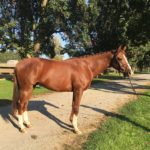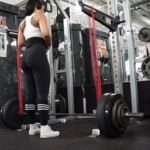
Hawk was well aware of work; he was also extremely comfortable with going in circles. But what he didn’t know about were legs, hands, bending, stopping and going … basic training aids that would take several months for him to adapt to and accept.
In the months to come, Hawk went from going around the indoor (which was similar to navigating a cruise ship in a small port) to graduating to shoulder-in, haunches-in, leg yield, swapping his leads (he already knew how; he just didn’t know my aid and why it was even necessary). Despite what many people think of the off-the-track Thoroughbred, Hawk was borderline lazy and required spurs.
Even now, he is still a lazy, kind-hearted soul.
I really felt like the work spent over the winter in teaching him basic aids—while he was learning to listen and trust—gave a brand new approach to sending the big man outdoors. I spent several weeks out of the ring, and then mixed it up with days of working hard and relaxing. I’ve had so much success with this regimen of testing a horse, then backing off, testing and backing off. It’s very similar to teaching a horse leg aids, adding pressure and, as soon as they think about stepping aside, releasing.

Chris Kappler said in my lesson with Hawk at his New Jersey farm, “The best riders can feel when to give before others can see it. It’s a feeling to know when to release the pressure.” Eventually the horse learns that the leg can be on their sides yet won’t always be there in an asking way, but more in a directional way. Knowing how far to push and how often to push has been a process that I read from each horse. They let you know how much they can handle, but as trainers, it is our job to know when that “too much” starts to creep up by balancing your ideas against them getting away with something.
I have found with the Thoroughbreds, and also other breeds, that you are better off to ask a question with the answer already available. Show the horse in a simple way what it means to move off your leg by taking the rein aid and asking them to step over with some direction. Eventually you will just use your leg. But allowing a horse to know the positive reward in doing what you ask is key to any training relationship.







